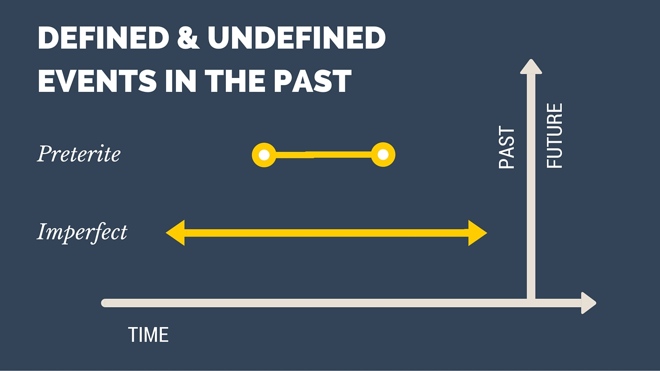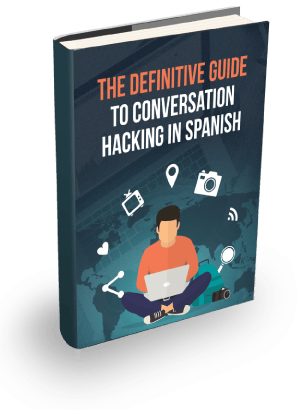4 out of 10 Spanish verbs are irregular.
This makes learning irregular verbs a big task. But, there are ways to simplify the process. You can reduce the workload by looking for patterns and common groups. This is particularly true when it comes to Spanish verbs in the past imperfect tense.
The past imperfect tense is one of ‘the big 3’ Spanish past tenses including the present perfect and past preterite.
There are, in fact, 7 past tenses in Spanish but I call the above tenses ‘the big 3’ because you only need to know these 3 tenses to be conversational in Spanish.
In this post, you’ll learn how to use the Spanish past imperfect tense. I will also share with you what is awesome about irregular Spanish verbs in the past imperfect. And here’s a hint of what’s to come: there are only 3 and ½ irregular verbs for the whole language!
Later, I’ll explain what I mean by ½ a verb. But first, let’s see where and how you should use the past imperfect tense.
How to use the Spanish past imperfect tense
The first and most critical distinction you have to make to understand the Spanish past imperfect is that some “events” in the past don’t have a clearly defined start or end.
What does that mean?
Let’s see an example. If I said:
“Yesterday, I drank a glass of water at 1:02 PM.”
Then from that statement, you know at 1:01 PM the event hadn’t started yet, and at 1:03 PM the event had finished. The “event” was me drinking a glass of water and it had a clearly defined start and end.
If, instead, I said:
“When we were young, my mother used to make us drink a glass of water with dinner every night.”
Now with this statement, there isn’t a single event anymore or a defined start and end. There are tens or hundreds or even thousands of glasses of water that were drunk.
When was the first glass drunk? When was the last? How many glasses have been consumed?
In this second scenario, you can’t answer these questions because there isn’t a clearly defined start and end. This type of scenario in the past signals that you need to use the Spanish past imperfect tense.
Here is an illustration that explains what I’m trying to say graphically.

Let’s consider another example.
Imagine a good friend tells you that someone you know just got engaged. In reaction to the news, you could say:
“Oh, I didn’t know!”
Here, the ‘not-knowing’ is the event, and it happened in the past because now in the present you do know.
With this example, you could argue that the event of ‘not-knowing’ did have an end (right now). But you couldn’t say that the ‘not-knowing’ had a start time.
When did you first ‘not-know’ they were engaged?
Did you start ‘not-knowing’ the moment your friend got engaged? Did you start ‘not-knowing’ when you were born because you couldn’t know stuff until you were born? Or does your ‘not-knowing’ extend right back to the start of time because nothing was known before then, right?
I know I’m getting a little philosophical here.
But, if you can grasp this argument, you will understand how and when to use the Spanish past imperfect tense.
If you want to hear more about the use of the Spanish past imperfect check out the podcast episode.
The Spanish past imperfect — regular conjugations
In the next two sections, you are going to learn every conjugation in existence for the Spanish language in the past imperfect tense. So get excited!
Firstly, the regular verb conjugations for the Spanish past imperfect come in two basic groups: one for ‘ar‘ verbs and one for ‘er‘ and ‘ir‘ verbs.
Apart from the 3 and 1/2 verbs, you are going to learn in the next section, every Spanish verb is conjugated like the verbs pensar (to think), volver (to return) and sentir (to feel).
The conjugations for these three verbs are:
| Person | Pensar | Volver | Sentir |
|---|---|---|---|
| Yo | Pensaba | Volvía | Sentía |
| Tú | Pensabas | Volvías | Sentías |
| Él / Ella | Pensaba | Volvía | Sentía |
| Nosotros | Pensábamos | Volvíamos | Sentíamos |
| Vosotros | Pensabais | Volvíais | Sentíais |
| Ellos | Pensaban | Volvían | Sentían |
Here are a few quick examples:
English: I used to think…
Español: Yo pensaba…
English: They used to return…
Español: Ellos volvían…
English: We used to feel…
Español: Nosotros sentíamos…
I chose these 3 verbs at random but any verb in Spanish will follow this pattern except for the verbs in the next section.
The past imperfect — irregular conjugations
Finally, you are up to the part where I explain what I mean by a 1/2 verb.
In Spanish, there are 3 irregular verbs in the past imperfect tense and one verb that is like one of these 3 but with a prefix.
The main 3 irregular verbs in the Spanish past imperfect tense are ser (to be), ir (to go) and ver (to see).
The other irregular verb that is like one of the main three but with a prefix is prever (to foresee). The reason I said 1/2 a verb is because you only have to memorize the conjugations for the verb ver and combine those with the prefix.
The conjugations for the three main irregular verbs are:
| Person | Ser | Ir | Ver |
|---|---|---|---|
| Yo | Era | Iba | Veía |
| Tú | Eras | Ibas | Veías |
| Él / Ella | Era | Iba | Veía |
| Nosotros | Éramos | Íbamos | Veíamos |
| Vosotros | Erais | Ibais | Veíais |
| Ellos | Eran | Iban | Veían |
For the conjugations of prever simply take the conjugations of ver and add the prefix pre- at the start. These are: preveía, preveías, preveía, preveíamos, preveíais, preveían.
The idea of prefixes is a great hack to cut down on the learning curve for Spanish verb conjugations. In every case that you find a set of conjugations for a given verb, any stem with an added prefix will share the same conjugations.
Let’s have a look at a few examples with the main irregular verbs for you to practice and commit to memory.
How to use the Spanish irregular past imperfect verbs
If you have read any post or listened to any podcast on Real Fast Spanish you will know that I focus on high-frequency words. I have left prever out of this section because it doesn’t even fall inside the top 2000 most frequent words in Spanish (in one frequency study it came in at 2105).
Take note of the following uses of ser, ir, and ver and see if you can use one of them in your next Spanish conversation.
1. Ser – To be
English: When I was little, I didn’t like cheese.
Español: Cuando era pequeño, no me gustaba el queso.
English: I met a girl last night and she was from Colombia.
Español: Conocí a una chica anoche y ella era de Colombia.
English: Yesterday, I did some exams and they were easy.
Español: Ayer hice unos exámenes y eran muy fáciles.
2. Ir – To go
English: We were going to go to the cinema at 8 pm, right?
Español: ¿Íbamos a ir al cine a las ocho, verdad?
English: Before buying the new car, I used to go to school on foot.
Español: Antes de comprar el nuevo coche, iba al colegio a pie.
English: Did you know from the start that you were going to go to France for vacation?
Español: ¿Sabías desde el principio que ibas a ir a Francia de vacaciones?
3. Ver – To see
English: Before growing up, I saw the world from a different point of view.
Español: Antes de crecer, veía el mundo desde un punto de vista diferente.
English: We used to talk for many hours every time we saw each other.
Español: Hablábamos durante muchas horas cada vez que nos veíamos.
English: How did you see yourself in your previous life?
Español: ¿Cómo te veías en tu vida anterior?
Summary
Learning Spanish verb conjugations is difficult. But, you can simplify the process by looking for patterns and learning irregular verbs in groups.
Once you have memorized the three regular and three irregular verb conjugations from this post, you don’t have to think about the past imperfect tense ever again. You now know every conjugation for every verb.
Once you have this tense covered, consider keeping up your momentum by also learning the 12 irregular verbs for the conditional and future tense.
What other sentences can you form using the Spanish past imperfect?




Great post, as usual! The way you explain things is just awesome. I think learning to conjugate verbs in Spanish is not as hard as knowing which would be the right tense to use in a given situation. Today I was writing to a Spanish friend of mine and I had doubts as to which tense would be right to use: preterite or imperfecto. I shared a video with my friend and afterwards I wanted to say: I think I sent it to you before. Creo que te lo enviaba antes. I thought the imperfect would make sense here since the sending action is not definite. Was I right hopefully? Or would the preterite “envié’ be correct? Thank you again for your outstanding website.
Hola Maan, I’m glad you liked the post and thanks for the comment. The sending is actually definite because it happened in a defined time period (even if you don’t remember when it was). Morever, the “sending” was a once off event. If you send something once then you need to use “el pretérito indefinido” (past simple), if you ‘used’ to send a letter once a week for years then you need to use “el pretérito imperfecto” (past imperfect). I hope that makes sense.
Gracias por tu respuesta. Ahora lo pillo. They say the best teachers teach from the heart, not from the book. I see how you put your heart into all the posts you write. So, thanks from the heart!
¡Gracias a ti Maan! Thanks for the kind words. I appreciate your support!
You mentioned that there are 7 Spanish past tenses. What are they?
Hola Aadila, I’m going to say them in Spanish because I know the names better in Spanish: pretérito perfecto, pretérito indefinido, pretérito imperfecto, pretérito pluscuamperfecto, pretérito imperfecto de subjuntivo, pretérito perfecto de subjuntivo, pretérito pluscuamperfecto de subjuntivo. We could also potentially include the progressive tenses in the past but we can view these as a combination of tenses and the condicional compuesto but this isn’t strictly used for the past. All that said, as I mentioned at the start of the article the big 3 (pretérito perfecto, pretérito indefinido, pretérito imperfecto) are the ones to master first as they are the most commonly used and all you need to have a strong and confident conversational level of Spanish.
Hola Andrew:
Cómo estás?
Tú eres un maestro muy inteligente y amable. Tus lecciones son muy comprensible. Me gusta la manera que tù explicas los temas diferentes y especialmente la conjugation de muchos tenses de los verbos.
Gracias por tu correo electrónico sobre los verbos y otras temas en español.
Qué tengas un buen día.
Muchas gracias Debbie 🙂
Ahora lo pillo. Now I get (catch) it. Is this an idiomatic expression?
Hola Vicent, yes “pillar” can behave colloquially like “to get”, “to catch” or “to nail (something)”.
Gracias, ahora yo pillaré mi camino.
Andrew
I don’t understand the last two ‘Ser’ examples. You have defined the sentences with ‘last night’ and ‘ yesterday’ . You’ve defined the timeframe in the past as evidenced by the use of pretetite conocer – conocì and hacer- hice. Surely therefore the rest of the sentence should use preterite and not the imperfect? Or, am I missing / not understanding something?
Thanks
Hola Rachel, yes this is a big topic!! And we cover it in a lot more detail in our level 2 course, El Cuentacuentos (the storyteller). But, in short, there are multiple events or timeframes in this sentence. Last night “I met” a girl, this “meeting” is a one-time event, but she “was” from Colombia. The “being” from Colombia is not a one-time event. How long has she been from Colombia for? We don’t know, so we need the imperfect for the description of her.
When do we use estaba pensando vs pensaba?
Hola Deborah, thanks for the question, this may need a whole separate article to answer. But, it comes down to a repeating action that occurred regularly versus a continuing action that happened continuously for an undefined length of time.